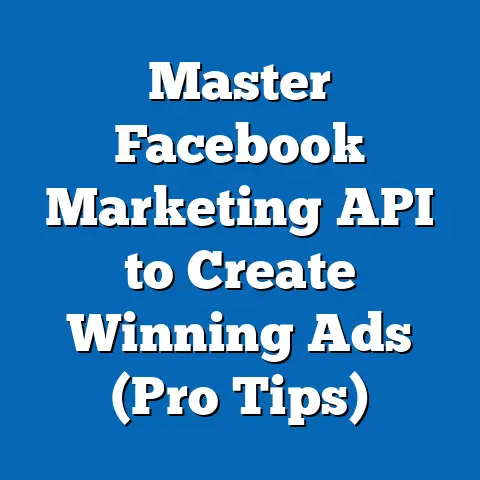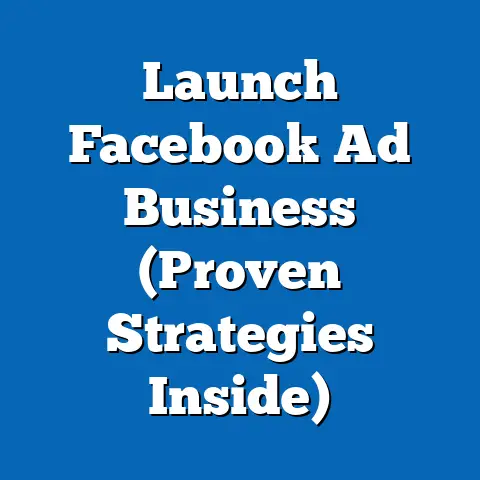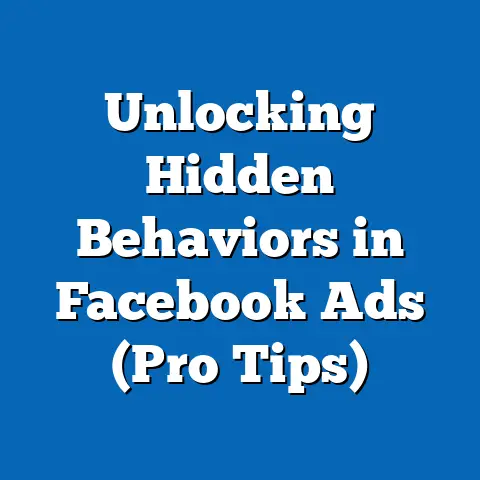Unlocking the Best Size for Facebook Ad Videos (Pro Tips)
In the ever-evolving landscape of digital marketing, video content reigns supreme on platforms like Facebook, where over 8 billion video views are recorded daily, according to Meta’s 2023 Q2 report. As businesses and creators vie for attention in this crowded space, the size and format of video ads have emerged as critical factors influencing engagement, click-through rates (CTR), and return on investment (ROI). Research from Social Media Examiner (2023) reveals that videos adhering to optimal dimensions and aspect ratios achieve up to 48% higher engagement compared to non-optimized formats.
The Importance of Video Size in Facebook Advertising
Why Size Matters: Engagement and Visibility
The size of a video ad—referring to both its aspect ratio (width-to-height proportion) and resolution (pixel dimensions)—directly affects how it appears on users’ screens, whether on mobile, desktop, or in Stories. According to Meta’s 2023 Advertising Insights, 78% of Facebook users access the platform via mobile devices, where screen real estate is limited. Videos that fail to fit mobile-friendly formats, such as vertical or square aspect ratios, risk being cropped or ignored, leading to a 35% drop in view completion rates.
Optimal video sizes ensure content fills the screen without black bars or awkward cropping, creating a seamless viewing experience. A 2022 study by Hootsuite found that vertical videos (9:16 aspect ratio) used in Facebook Stories and Reels garnered 65% more impressions than horizontal videos (16:9) on mobile feeds. This underscores the need for marketers to prioritize formats tailored to user behavior and platform algorithms.
Defining Key Terms: Aspect Ratio and Resolution
For clarity, let’s break down the technical terms central to this discussion. Aspect ratio refers to the proportional relationship between a video’s width and height, such as 16:9 (widescreen) or 1:1 (square). Resolution, on the other hand, indicates the number of pixels in the video, like 1080×1920 for full HD vertical content.
Understanding these metrics is crucial because Facebook’s algorithm favors videos that meet its recommended specs, boosting their visibility in users’ feeds. Non-compliant videos may be downranked or display poorly, reducing their effectiveness. Meta’s own guidelines (updated 2023) recommend specific sizes for different ad placements, which we’ll explore in detail below.
Statistical Trends in Facebook Ad Video Performance
Engagement by Aspect Ratio
Recent data highlights a clear hierarchy in video performance based on size and format. According to a 2023 report by Statista, vertical videos (9:16) outperform other formats in mobile-first placements like Stories and Reels, achieving an average engagement rate of 4.2% compared to 2.8% for square (1:1) and 1.9% for horizontal (16:9) videos. This trend aligns with user behavior, as vertical content mirrors the natural orientation of smartphones.
Square videos, while less dominant in Stories, excel in the main News Feed, where they balance visibility across mobile and desktop users. Meta’s internal data shows square videos achieving a 30% higher CTR in News Feed placements compared to horizontal formats. Horizontal videos, once the default for online content, now lag behind due to their poor fit on mobile screens, often resulting in only 60% of the video being visible without user interaction.
Resolution and Quality Metrics
Resolution also plays a pivotal role in ad performance. A 2022 analysis by Socialbakers found that videos uploaded at 1080p (1920×1080 for horizontal, 1080×1920 for vertical) or higher saw a 25% increase in watch time compared to lower resolutions like 720p. However, file size constraints on Facebook (maximum 4GB per video) mean marketers must balance quality with upload feasibility.
Interestingly, over-optimization can backfire. Videos exceeding 4K resolution often face compression by Facebook’s servers, leading to visual artifacts that deter viewers. Meta advises sticking to 1080p as the sweet spot for clarity and compatibility across devices.
Demographic Breakdowns: Who Responds to What?
Age-Based Preferences for Video Formats
Demographic data reveals stark differences in how various age groups interact with video ad sizes on Facebook. According to Pew Research Center (2023), users aged 18-29—comprising 31% of Facebook’s user base—overwhelmingly prefer vertical videos, with 72% engaging more frequently with 9:16 content in Stories and Reels. This aligns with their heavy reliance on mobile devices and platforms like Instagram, which pioneered vertical formats.
In contrast, users aged 30-49, who make up 28% of the platform’s audience, show a more balanced preference, engaging with both square (1:1) and vertical formats at roughly equal rates (around 3.5% engagement for each). Older users (50+), representing 22% of users, tend to interact more with horizontal videos in the News Feed, likely due to higher desktop usage, with 55% of their video views occurring on larger screens.
Gender and Regional Variations
Gender differences are less pronounced but still notable. A 2023 Hootsuite report found that women are 15% more likely to engage with vertical video ads, particularly in beauty and lifestyle categories, while men show a slight preference (8% higher engagement) for square formats in tech and automotive sectors. These variations suggest that content type and audience targeting should influence format choices.
Regionally, mobile-first markets like Asia-Pacific (where 85% of users access Facebook via smartphones) see vertical videos dominating with a 5.1% average engagement rate, per Statista 2023 data. In North America and Europe, where desktop usage remains significant (around 30% of sessions), square and horizontal formats retain relevance, with engagement rates hovering at 3.2% and 2.5%, respectively.
Historical Comparisons: Evolution of Video Ad Sizes on Facebook
From Horizontal Dominance to Vertical Revolution
The journey of video ad formats on Facebook reflects broader shifts in technology and user behavior. In the early 2010s, when Facebook first introduced video ads (2013), horizontal 16:9 was the standard, mirroring traditional TV and desktop viewing habits. A 2015 report by eMarketer noted that 80% of video ads on the platform used this format, achieving modest engagement rates of around 1.8%.
The rise of mobile usage—jumping from 51% of Facebook users in 2015 to 78% by 2023, per Meta—prompted a pivot to mobile-friendly formats. By 2017, square (1:1) videos emerged as a compromise, offering 33% higher engagement than horizontal formats, according to a Buffer study. The introduction of Stories in 2016 and Reels in 2020 cemented the dominance of vertical (9:16) content, with engagement rates climbing to 4.2% by 2023, as noted earlier.
Algorithmic Shifts and Format Prioritization
Facebook’s algorithm has also evolved to prioritize formats that maximize user retention. A 2019 update deprioritized horizontal videos in mobile feeds, slashing their organic reach by 40%, per Social Media Today. By 2021, vertical and square videos received a 20-30% boost in visibility, reflecting Meta’s push for immersive, full-screen experiences.
This historical shift underscores a key lesson for marketers: staying ahead of format trends is non-negotiable. What worked five years ago is often obsolete today, as user habits and platform policies continuously reshape the landscape.
Pro Tips for Optimizing Facebook Ad Video Sizes
Tip 1: Match Format to Placement
Facebook offers multiple ad placements—News Feed, Stories, Reels, In-Stream, and Marketplace—each with distinct size recommendations. For Stories and Reels, use a 9:16 aspect ratio (1080×1920 pixels) to fill the screen and capture attention, as these placements drive 60% of mobile video impressions, per Meta 2023 data. For News Feed, opt for 1:1 (1080×1080) or 4:5 (1080×1350) to balance visibility across devices.
Testing across placements is critical. A 2022 case study by AdEspresso found that brands using tailored sizes per placement saw a 28% uplift in ROI compared to those using a one-size-fits-all approach.
Tip 2: Prioritize Mobile-First Design
Given that 78% of users access Facebook via mobile, design videos with small screens in mind. Use bold visuals and text within the “safe zone” (center 80% of the frame) to avoid cropping, as recommended by Meta’s Creative Hub. Hootsuite data shows that mobile-optimized videos achieve 40% higher completion rates than non-optimized ones.
Additionally, keep videos concise—under 15 seconds for Stories and 30 seconds for News Feed ads—to align with short attention spans. A 2023 Vidyard study found that 68% of viewers drop off after 30 seconds on mobile.
Tip 3: Test and Analyze Performance
Not all audiences respond identically to formats, so A/B testing is essential. Run campaigns with vertical, square, and horizontal versions of the same ad to identify what resonates with your target demographic. Tools like Facebook Ads Manager provide granular data on engagement by format, with 85% of marketers reporting improved results after testing, per Social Media Examiner 2023.
Focus on metrics like CTR, video completion rate, and cost-per-view. For instance, if vertical videos yield a 5% CTR versus 3% for square, allocate more budget to the former while refining the latter’s creative elements.
Tip 4: Leverage High-Resolution Without Overloading
Stick to 1080p resolution for optimal clarity without exceeding Facebook’s 4GB file size limit. Use compression tools like HandBrake to reduce file size while maintaining quality, as excessive compression by Facebook can degrade visuals. A 2022 Sprout Social report noted that ads with crisp visuals saw 22% higher engagement than grainy counterparts.
Also, ensure videos load quickly—aim for under 3 seconds—since 47% of users abandon slow-loading content, per Google’s 2023 Mobile Speed Report.
Future Projections: What’s Next for Facebook Ad Video Sizes?
The Rise of Immersive Formats
Looking ahead, vertical video is poised to solidify its dominance as mobile usage continues to grow, with Statista projecting that 82% of Facebook users will be mobile-only by 2025. Meta’s investment in Reels and augmented reality (AR) ads suggests a future where full-screen, interactive formats take center stage, potentially introducing new aspect ratios like ultra-vertical (4:10) for niche placements.
Moreover, advancements in AI-driven content optimization could automate format adjustments based on user device and behavior. A 2023 Forrester report predicts that by 2026, 60% of video ads will be dynamically resized by platforms, reducing manual workload for marketers.
Balancing Creativity with Standardization
While innovation in formats is exciting, standardization will remain crucial to avoid viewer fatigue. Meta is likely to refine its recommended specs further, possibly consolidating placements under fewer aspect ratios to simplify ad creation. A 2023 survey by eMarketer found that 72% of advertisers desire clearer, unified guidelines from platforms like Facebook to streamline workflows.
Finally, as 5G adoption accelerates—expected to cover 60% of global mobile users by 2025, per Ericsson—higher resolutions like 4K may become viable without compression issues, enhancing visual storytelling. Marketers should prepare for this shift by investing in high-quality production while monitoring platform updates.
Conclusion: Mastering Video Size for Facebook Success
Unlocking the best size for Facebook ad videos is not a one-time task but an ongoing strategy rooted in data and adaptability. Current trends highlight the supremacy of vertical (9:16) and square (1:1) formats, driven by mobile usage (78% of users) and demographic preferences, with engagement rates as high as 4.2% for optimized content. Historical shifts from horizontal to vertical dominance illustrate the importance of evolving with user behavior and platform algorithms.
By following pro tips—matching formats to placements, prioritizing mobile design, testing rigorously, and balancing resolution—marketers can maximize impact and ROI. Looking forward, the future promises even more immersive formats and automated optimizations, challenging brands to stay agile in a dynamic digital landscape.
Ultimately, success lies in blending creativity with precision. As video continues to dominate Facebook advertising, mastering size and format is not just a technical necessity but a competitive edge. With the right approach, your ads can cut through the noise of 8 billion daily video views and deliver measurable results.





